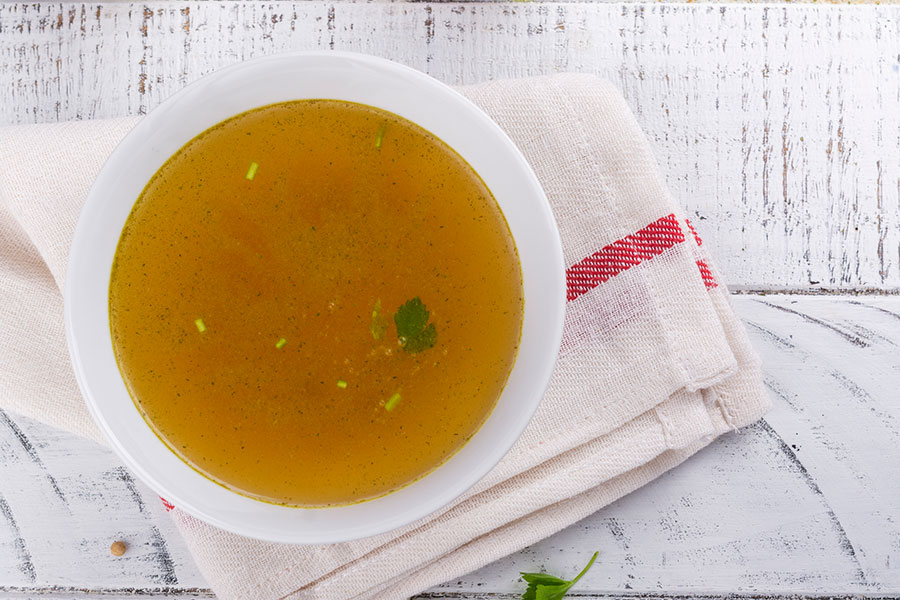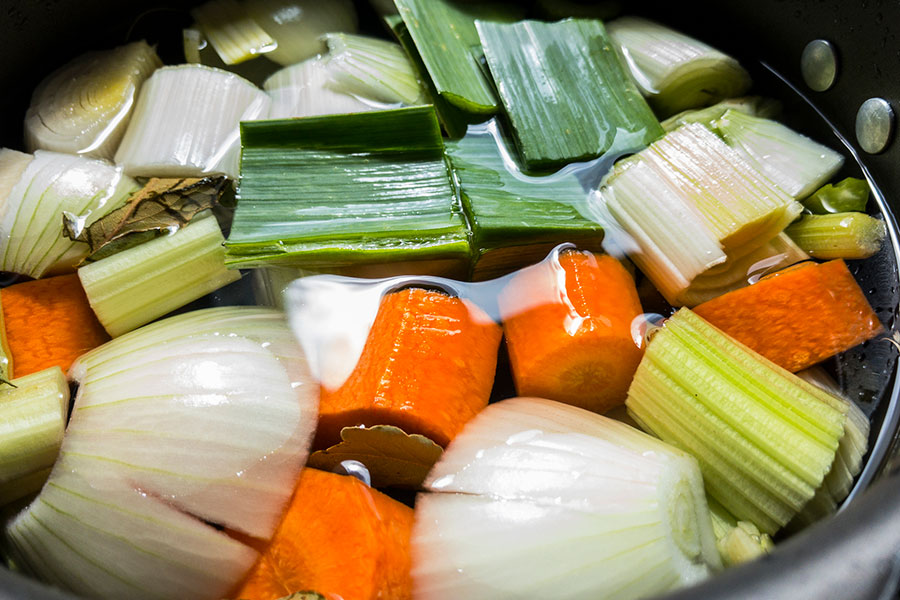Chef shares tips – and a recipe – for making great stocks and broths
It started innocently: a conversation among the techlifetoday team about what to do with turkey bones leftover from Thanksgiving dinner. The outcome was a lively but confused debate about the difference between stock and broth.
“Is stock made with bones and broth made vegetables?”
“So then what’s bone broth? Is it actually just stock?”
“If bone broth is its own thing, then how does it differ from stock?!”
“Do they actually just mean the same thing?”
To settle the matter once and for all, we asked Hong Chew (Culinary Arts ’93), chair of Culinary Arts and Professional Food Studies, to explain the differences and similarities, and to illustrate with a recipe. Spoiler alert: the difference is about as clear as a broth that hasn’t been cooked long enough. Or do we mean stock?
Techlifetoday: OK, let’s start from the beginning. What is stock?
Hong Chew: In classical French cuisine, stock is made with bones, with meat and cartilage attached, that are simmered. Stock also includes adding a vegetable component, or a mirepoix (onion, celery, carrot), along with an acidic ingredient. This could be a tomato-based product or wine. You can also add a few fresh herbs like parsley stems, bay leaf and thyme. Stock is typically never seasoned with salt because you’re getting all the flavour from the bones.
This is simmered for a long time to extract the flavour from the bones.
What is stock used for?
We tend to use stock for the base of soups. For example, ramen shops will use a good pork bone stock to make their soup. You would also use stock as the base for making sauces or to braise meat.
Ramen shops will use a good pork bone stock to make their soup.
What kinds of stock can you make?
The bones that you can use to make stock can include beef, poultry, fish and pork.
How long does it take to make a stock?
If you’re making a fish stock, it would take four to five hours. Chicken takes about four to six hours. A beef stock requires browning the bones for more colour and flavour, and takes six to eight hours or overnight. A good stock has drawn out the gelatine and collagen from the bones.

So, what’s the definition of broth?
Broth doesn’t take as much time to prepare. It is generally made with a combination of meat and vegetables. For example, in my Asian culture we make a chicken broth by submerging a stewing chicken in cold water with some veggies and herbs and simmering it for a few hours for chicken soup.
Because broth is made fairly quickly, you would season it with salt and pepper to make up for the shorter cooking time. Some people would also use seasoning sauces like worcestershire or maggi sauce. Broth is a lot lighter in texture compared to a stock.
OK, then is bone broth just stock?
When you hear the term bone broth, it’s misleading because it’s actually stock. But bone broth probably sounds better than bone stock!
Can you make a stock with vegetables?
Absolutely. It’s just a matter of the type of vegetables. Generally speaking, you use onions, garlic, celery and carrots – the latter for the beta carotene, which adds an orange colour.
What are some common mistakes when making stock or broth?
Rushing the process. In most cases, whether you’re making stock or broth, people tend to bring it to a boil too quickly. You want to give it time and make as clear of a stock or broth as possible. If you bring it to a boil too quickly, it doesn’t allow time for the blood residues in the bones to rise to the top.
For a stock, rinse your bones in cold water and avoid starting with hot water, which would come to a boil too quickly. Then skim the impurities [the frothy, foamy scummy bits] from the top.
What’s the difference between simmering and boiling?
The big difference is time and the rate of agitation of the liquid. Simmering means cooking in a liquid that is bubbling gently at a temperature of about 185 to 200 F (85 to 94 C). This allows for a gradual release of flavour for better extraction of the aromatics.
Boiling means cooking in a liquid that is bubbling rapidly and greatly agitated. Water boils at 212 F (100 C) at sea level. There’s less flavour extraction but it’s a faster process.
What is the best – and safest – way to cool a pot of stock or broth to avoid bacteria growth?
There are a few possible methods:
- Pour stock or broth while still hot into several smaller containers. This allows for rapid cooling.
- Place the container of hot stock or broth in a cold-water bath. Ensure the container is set on a rack to allow for water circulation.
Any last bits of advice before we try making our own?
Using carcasses and cuts of meat that have a lot of cartilage is important. Necks and backs are a good example. My grandmother and my mom used chicken feet and I never understood why until I realized that it’s the gelatin and the cartilage in the feet that gives you richness. If your chilled stock is gelatinous, you have made a good stock.
Chef Chew’s vegetable stock recipe

First, a note about vegetables used for veggie stocks. If you want a particular flavour to predominate, use a larger quantity of that vegetable. For example, if you want a broth with strong asparagus flavours, use a larger quantity of asparagus and smaller amounts of neutral vegetables such as onion and celery.
Starchy vegetables, such as potatoes, sweet potatoes and winter squash make a stock appear cloudy. Use them only if clarity is not important.
Some vegetables, especially strong‐flavoured ones, are best avoided. Brussels sprouts, cauliflower and artichokes can overwhelm a stock with strong flavours and odours. Dark green leafy vegetables, especially spinach, develop an unpleasant flavour when cooked for a long time.
Ingredients
- 4 lbs (2 kg) vegetables, such as onions, carrots, celery, fennel. Depending on the flavour profile you are trying to achieve, you can add more of one ingredient over another. For example, more onions/leeks over carrots or fennel
- Bunch of herbs, such as fresh thyme, parsley stems, bay leaves, garlic. You can bundle them together and tie it with string as a bouquet garni
- Spices, such as a teaspoon of black peppercorns, whole cloves
- 1 gallon (4L) water
- Wine (optional; e.g., white wine to enhance the flavour)
Method
- Add a small amount of oil or butter to a stock pot and sweat vegetables over low to medium heat. This is optional but gives veggies a mellow flavour.
- Add water.
- Simmer long enough to extract flavours but not so long that flavors are lost, 30 - 45 minutes. You’ll know it’s done by the rich flavour profile in combination with colour of stock and clarity.
- Cool your stock using one of the methods outlined above.
Banner image GMVozd/istockphoto.com